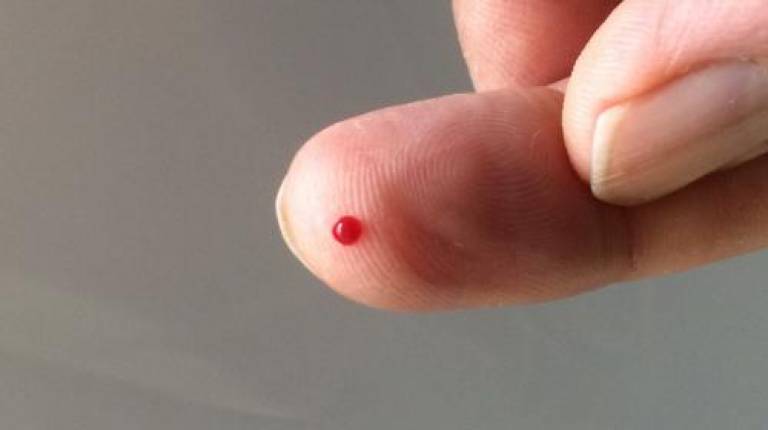Blood could be an effective treatment for dry eye syndrome
29 August 2017

A small drop of a blood could relieve symptoms of severe dry eye, according to new research.
In a study supported by the National Institute of Health Research Biomedical Research Centre at Moorfields Eye Hospital and UCL Institute of Ophthalmology, patients who were asked to apply a pricked and bleeding fingertip to their eye/s four times a day reported significant improvements in their symptoms.
Our tears contain enzymes and vitamins that help maintain and repair the cornea, the clear window at the front of the eye. Similar nutrients that encourage growth are also present in our blood and it’s believed that this is partly responsible for the improvements shown in the study. The study, published in Eye, is the first to explore the use of whole blood as a substitute for tears.
Dry eye syndrome is a condition that occurs when the eyes don’t make enough tears, or the tears evaporate too quickly. This leads to the eyes drying out and becoming red, swollen and irritated. Drops that lubricate the eye or reduce inflammation are usually recommended for patients with dry eyes but they do not contain the key nutrients found in our tears and blood that encourage cells to repair. In severe cases, eye drops made from blood serum can be effective but they are expensive and are not readily available.
“Dry eye syndrome is very common and I often see patients whose sight is severely affected by the condition,” said Professor Anant Sharma, consultant ophthalmologist at Moorfields Eye Centre at Bedford Hospital and principal investigator for the study. “Knowing that our blood has significant growth properties, we decided to see if a whole drop of blood applied to the eye could provide effective relief.”
The study consisted of 16 patients with severe dry eye syndrome. Using a lancet, patients were taught how to safely draw a small drop of blood from their own finger and apply to the lower part of the affected eye. The procedure was carried out four times a day for eight weeks. Results show that damage to the eye surface in participants was halved and that this combined with a significant improvement in vision. Symptoms worsened when the treatment was stopped and improved again when it was re-started.
Professor Sharma added: “This is a potential game changer in the treatment of dry eye. It is simple, inexpensive and early results suggest it is effective with excellent results and no serious side effects. We are planning a larger randomised controlled study to assess the long term safety of the method. We’re also hopeful that it could benefit patients with other conditions that affect the front of the eye, such as ulcers, infections and corneal erosion syndrome.”
While these findings present hope for people who suffer from severe dry eye, the study is still in its early stages and people who suffer from dry eyes should speak with their doctor. Once a diagnosis is made, your doctor will advise on the right treatment for you. Using blood as a treatment for symptoms should not be attempted without guidance from a medical professional.
The NIHR Biomedical Research Centre is a partnership between Moorfields Eye Hospital NHS Foundation Trust and UCL Institute of Ophthalmology. Further studies will take place at Moorfields Eye Centre at Bedford, Moorfields at City Road and Moorfields Eye Centre at St George’s.
 Close
Close

